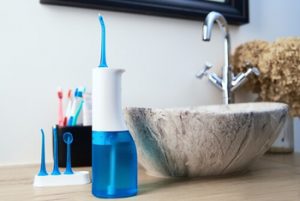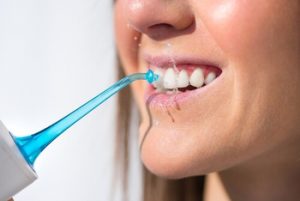Water flossers have rapidly gained popularity in Australia as a sought-after addition to oral care routines. With their promise to improve gum health and effortlessly remove food particles from those hard-to-reach areas, many people are switching from traditional flossing. But, there’s been a growing concern – can a water flosser damage gums?
Let’s delve deeper and separate fact from fiction.
What is a Water Flosser?
 Often referred to by the brand name “Waterpik”, a water flosser is an oral irrigator. It shoots a thin stream of water to dislodge food debris and plaque along the gum line and between the teeth. Given its efficiency in removing plaque and its ability to reach the back teeth with ease, the device has become a favourite, especially for those with dental work like braces.
Often referred to by the brand name “Waterpik”, a water flosser is an oral irrigator. It shoots a thin stream of water to dislodge food debris and plaque along the gum line and between the teeth. Given its efficiency in removing plaque and its ability to reach the back teeth with ease, the device has become a favourite, especially for those with dental work like braces.
Waterpik Water Flosser Usage Benefits
A majority of individuals who use a Waterpik swear by its efficacy. Not only can it remove food particles that traditional brushing might miss, but it also does wonders for improving gum health. One of its biggest advantages is its ability to reduce the risk of gum disease.
When plaque accumulates, it can cause inflammation, leading to periodontal disease. Symptoms like bleeding gums, tooth loss, and periodontal pockets characterise this condition. A water flosser is clinically proven to combat these issues by removing plaque efficiently.
Moreover, for those who find traditional flossing a tad challenging or painful, using a Waterpik is more convenient. With adjustable water pressure settings, you can ensure the stream is neither too strong nor too weak for your teeth or gums.
Concerns: Can Water Flosser Damage Gums?
Most people’s primary concern is whether water flossers, given their pressure, can damage gums. When used correctly and in the right settings, water flossers are generally safe and can be a boon for oral health.
However, there are some factors to consider:
- Water Pressure: It’s essential to start on the lowest pressure setting when using a water flosser for the first time. This will prevent splashing and ensure that your gums acclimate to the pressure. Over time, if you feel comfortable, you can adjust the settings. But remember, the goal is to clean plaque, not to injure the gums.
- Technique Matters: Just like brushing, there’s a correct way of using a water flosser. The tip should be held at a right angle to the teeth, ensuring the water stream targets the gum line and the spaces between teeth. Keeping the mouth slightly closed while flossing will prevent water from splashing out.
- Sensitive Gums: For those with pre-existing gum issues like bleeding or gum disease, it’s advisable to be extra cautious. While a water flosser can help improve your periodontal health status by removing debris and tartar buildup, using it on the highest setting can exacerbate the problem. To avoid discomfort, it’s always wise to begin with warm water and the lowest setting.
Water Flosser vs. Traditional Floss
Both water flossers and traditional floss have their merits. String floss is excellent for scraping off the plaque from the teeth surfaces, especially from the bottom teeth. On the other hand, water flossers excel in flushing out debris and plaque from hard-to-reach areas. It’s not a matter of one being better than the other, but rather, complementing each other for optimal oral health.
Common Myths Debunked
 Water flossers can replace brushing: A water flosser is complementary to your oral care routine, not a replacement for brushing or flossing. While it removes plaque and food particles efficiently, brushing with fluoride toothpaste is imperative for preventing tooth decay.
Water flossers can replace brushing: A water flosser is complementary to your oral care routine, not a replacement for brushing or flossing. While it removes plaque and food particles efficiently, brushing with fluoride toothpaste is imperative for preventing tooth decay.- Bleeding means the water flosser is too strong: If your gums bleed while using a Waterpik, it could indicate gum disease or inflammation, not necessarily the pressure of the water flosser. However, always start with the lowest setting and consult a dentist if bleeding persists for over two weeks.
The Role of Water Temperature in Water Flossing
One often overlooked aspect of using a water flosser is the temperature of the water. Warm water is generally recommended, especially for individuals with sensitive teeth or gums. Using warm water can provide a soothing experience, reducing the potential shock or discomfort that cold water might induce. Furthermore, warm water can assist in reducing any inflammation, promoting better blood circulation in the gum tissue.
Water flossers also come equipped with reservoirs that can hold ample water for a complete flossing session. Filling the reservoir with lukewarm water is worthwhile to ensure you’re maximising the benefits of your water flosser. However, avoid using overly hot water, which can lead to unintended damage or exacerbate sensitivity.
Conclusion
Water flossers are a fantastic tool for enhancing gum health, reaching those tricky areas, and ensuring a thorough clean. But like any tool, they need to be used correctly. With the right technique and pressure setting, the chances of a water flosser causing damage to the gums are minimal. But as always, it’s essential to listen to your body. It might be time to consult a dentist if you experience discomfort or if your gums bleed consistently.
Contact our local Castle Hill dental clinic at (02) 8806 3799 for more information about water flossers. Our team is here to guide and assist you on your journey to a radiant, healthy smile.
References:
https://www.colgate.com/en-us/oral-health/selecting-dental-products/should-you-consider-a-water-flosser
https://www.linkedin.com/pulse/can-water-flosser-damage-teeth-gums-roger-lee









